 Mathematical "E" Words
Mathematical "E" Words
*Dictionary
Alert
edge Any side of a polyhedron's faces.
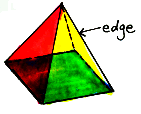
elevations Two-dimensional views of three-dimensional figures given from the top, front, or sides. Elevations usually include measurements and a scale.
empty set
A set containing no elements. Also know as the null set. Symbols used
to denote this set are,
![]() .
.
endpoint
A point at the end of a segment or the starting point of a ray.

endpoint of a ray The starting point of a ray.
ends of
a kite
The common vertices of the equal sides of the kite.
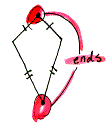
Equal
Fractions Property If
the numerator and denominator of a fraction are both multiplied ( or divided
) by the same nonzero number, then the resulting fractions are equal.

This example works because 3/3 is another name for one, and any
number when multiplied by one retains its original value.
equally likely outcomes Outcomes in a situation where each outcome is assumed to occur as often as every other outcome.
equation A sentence with an equal sign.
Ex: 3x + 7 = 19
equation of the form x + a = b An equation in which an unknown number x is added to a known number a, resulting in a known number b.
Ex: x + 8 =16
equation of the form ax = b An equation in which the unknown number x is multiplied by a known number a, resulting in a known number b.
Ex: 4x = 64
equation of the form ax + b = c An equation in which an unknown number x is multiplied by a known number a, then added to a known number b, resulting in a known number c.
Ex: 2x + 7 = 27
equation of the form ax + b = cx + d An equation in which the same unknown number x is multiplied by numbers a and c and added to known numbers b and d, resulting in equal values.
Ex: 5x + 8 = 3x + -10
equiangular polygon A polygon with all angles of equal measure.
equidistant At the same distance.
equilateral polygon A polygon with all sides of equal length.
equilateral triangle A triangle in which all the sides have the same length.
equivalent formulas Formulas in which the same numbers work.
equivalent sentences Sentences that have exactly the same solutions.
estimate A number which is near another number. Also called approximation.
Estimation Principle If two numbers are nearly equal, then when one is substituted for the other in a computation will be nearly equal.
Euclid A
Greek mathematician, who lived about 300 B.C., famous for his Elements,
a collection of theorems and problems that forms a logical system of geometry.
Euclid also wrote on conic sections, optics, algebra and numbers. He proved
that the number of primes is infinite. He founded the first school of
mathematics at Alexandria. For more than 2,000 years, Euclidean geometry
was the only kind taught in schools.
Euclidean geometry The geometry based on Euclid's axioms.
evaluating
an expression Finding
the value of an algebraic expression by substituting a value for the variable(s)
and then applying the order
of operations, PEMDAS (parentheses, exponents, multiplication and
division from left to right, and addition and subtraction from left to
right).
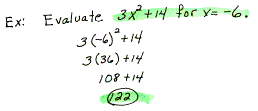
evaluating a numerical expression Working out the arithmetic in a numerical expression. The order of operations, PEMDAS (parentheses, exponents, multiplication and division from left to right, and addition and subtraction from left to right), must be followed when evaluating any numerical expression
even node
A node which is the endpoint of an even number of arcs in a network.

event A collection of possible outcomes of an experiment.
exercise A question which you know how to answer.
expansion A size change with magnitude greater than one.
exponent In the power x^n, n is the exponent.
extended ratio A sequence of three or more numbers representing the relative sizes of the numbers (or quantities).
Ex:
This 30, 60, 90 degree triangle has angles which follow a 1:2:3 ratio because 60 is two times bigger than 30, and 90 is three times bigger than 30.
exterior
angle
An angle formed by two lines and a transversal whose interior contains
no points between the two lines. An angle which forms a linear pair with
an angle of a given polygon.
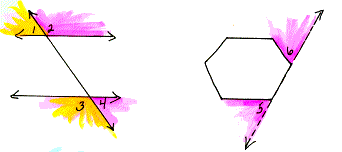
Above you see angles 1, 2, 3, 4, 5, and 6 are all exterior angles.
NOTE: If the two lines that are cut by the transversal are parallel,
then the alternate exterior angles, 1&4, 2&3, will be congruent
exterior
of a circle
The set of points at a distance greater than the radius from the
center of the circle. It's just everything not in or on the circle itself.
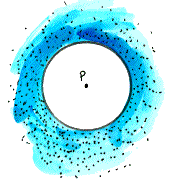
exterior of a figure When a figure separates the plane into two parts, one bounded and one not, the unbounded part.
exterior
of an angle
A nonzero angle separates the plane into two sets of points. If the angle
is not straight, the non-convex set is the exterior of the angle.

extremes of a proportion In the proportion a/b= c/d, the numbers a and d.
 Remember
that b and c are called the means, and that
the product of the means is
always equal to the product of the extremes in any proportion.
Remember
that b and c are called the means, and that
the product of the means is
always equal to the product of the extremes in any proportion.
Home | About
Us | Algebra| Dictionary | Games | Geometry | Gym | Humor | Lab | Magic | Natural Math | PreAlgebra | Resources | Teachers Only | Toolbox | Treasures | Videos | Wonders | Writings |
Copyright © 1999-2020 themathlab.com

